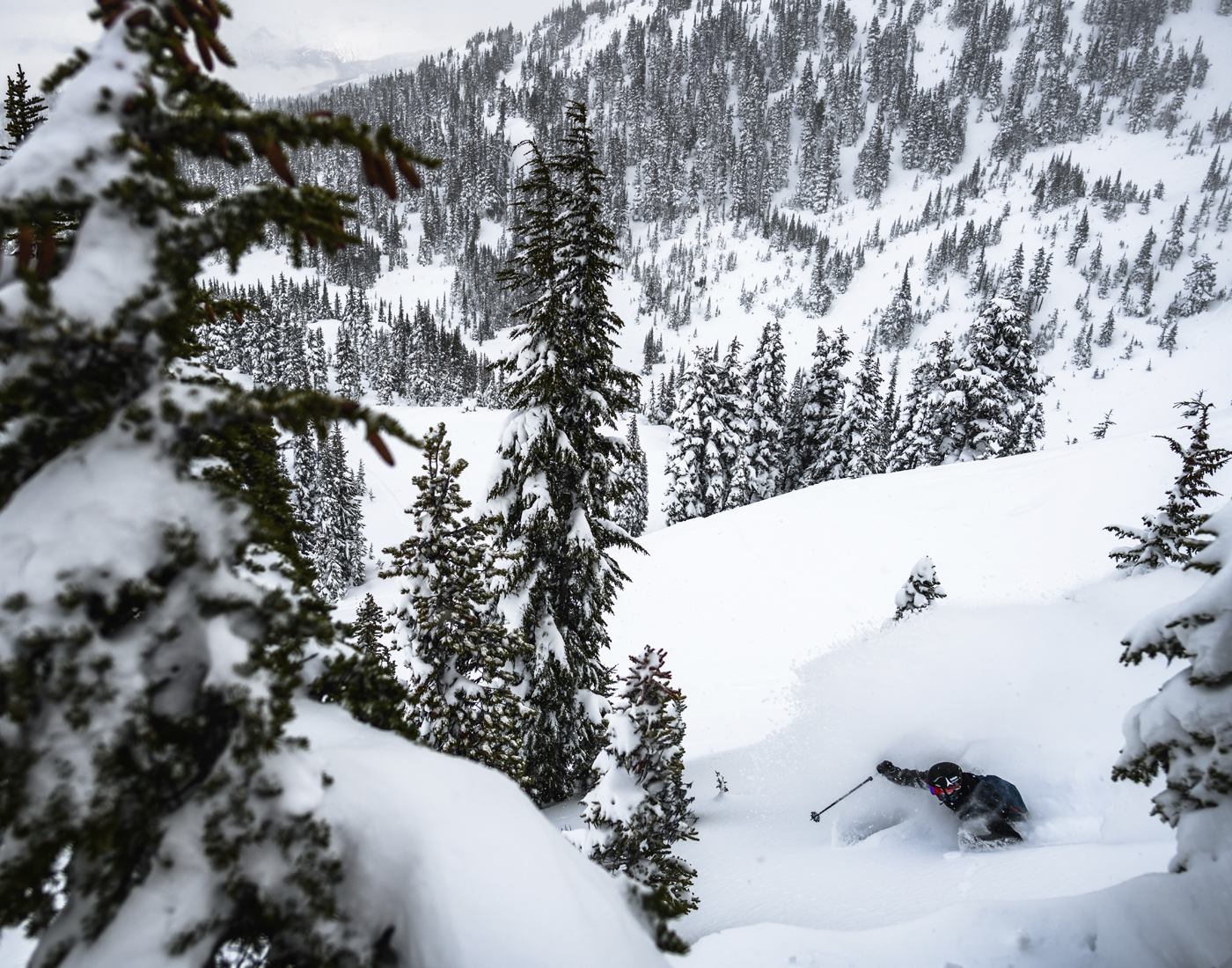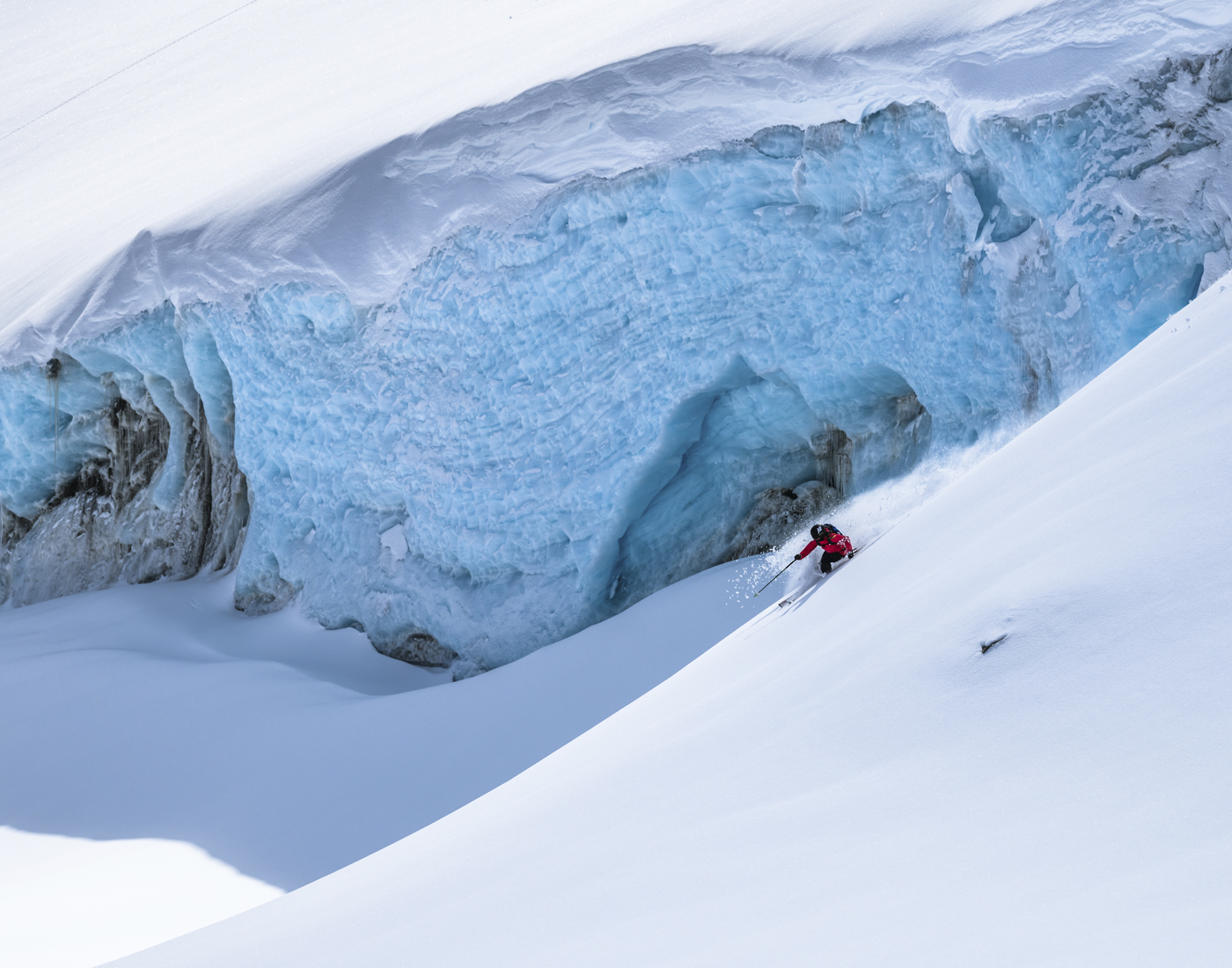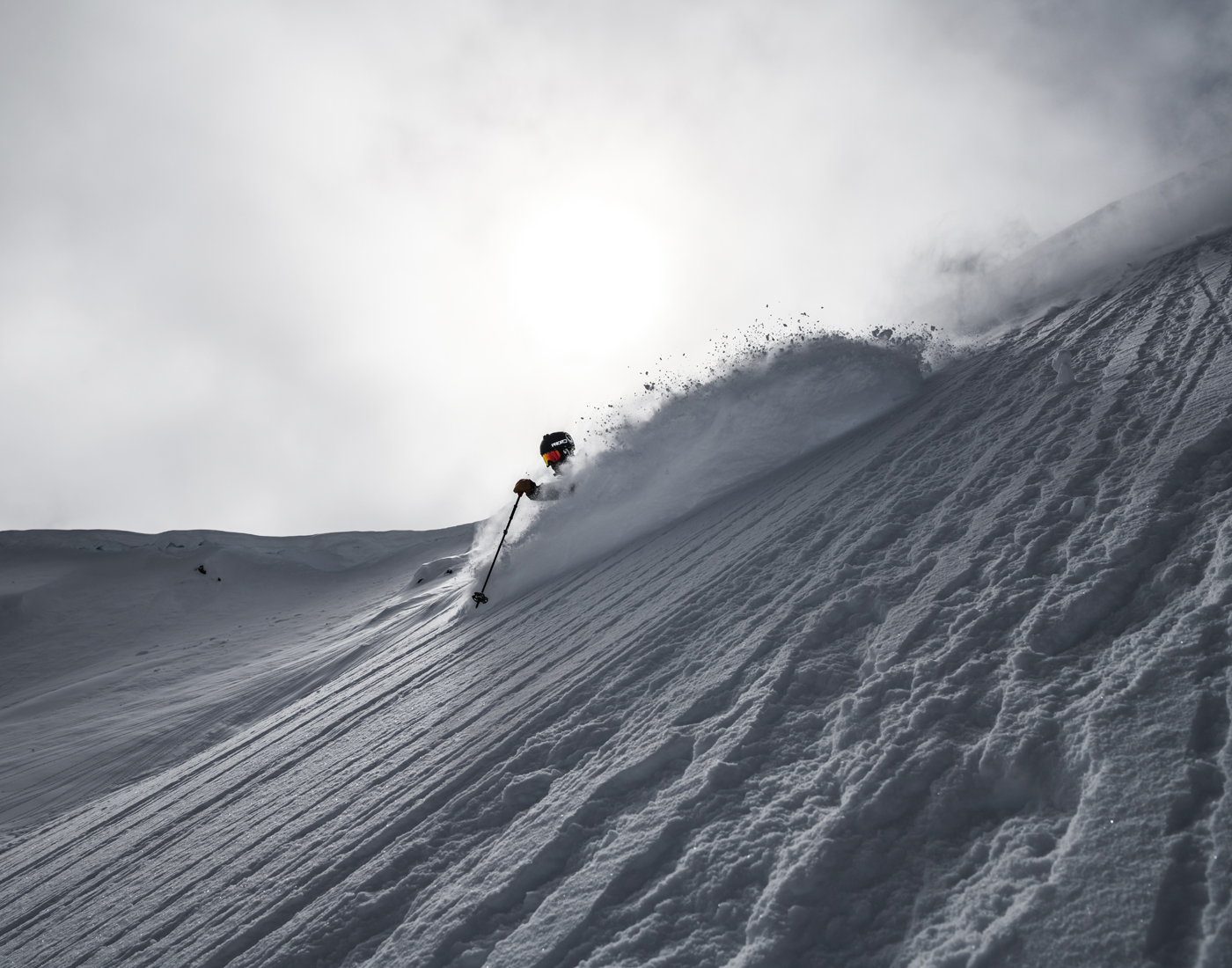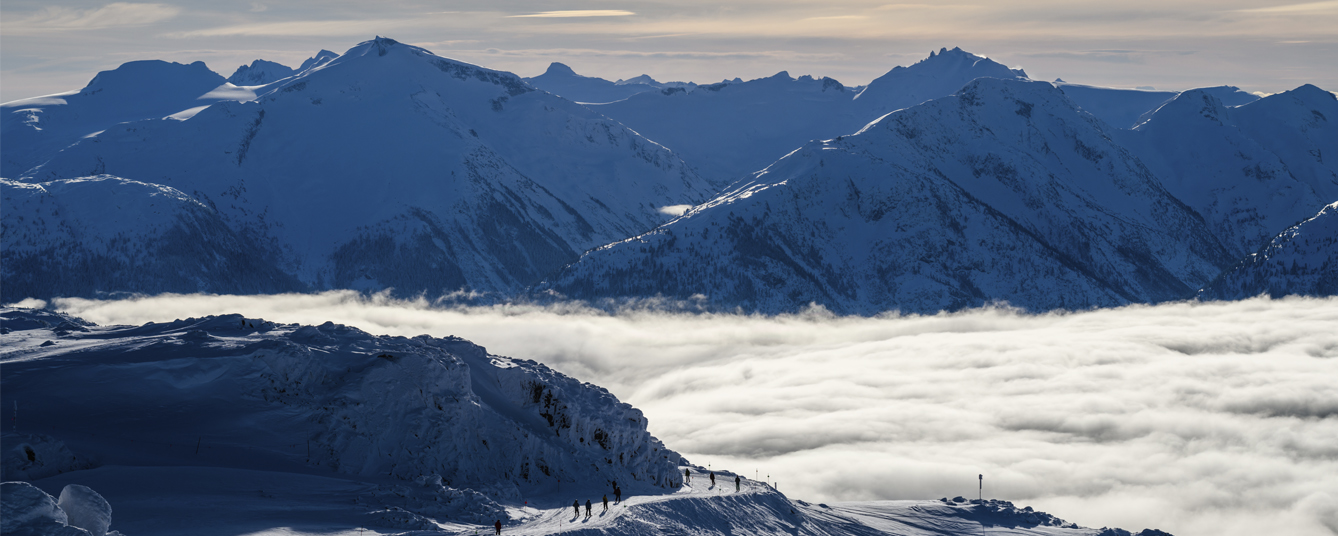Whistler’s Endless Wonder
When it comes to discovering all of the powdery aprons, neighborhood bars and off-hill diversions at this coastal colossus, one lifetime is simply not enough. The endeavor, however, would be a life well-lived, indeed.
WORDS • LESLIE ANTHONY | PHOTOS • ANDREW STRAIN
The first time I visited Whistler, during the almost prehistoric late-1970s, I knew nothing about the place. A friend and I had driven over from Banff, where we were wintering amidst the icy fingers of the Rockies, to visit a university friend who was ski-patrolling a mountain he assured us we had to visit.
We made our way through Vancouver in an unreliable van (as most were in those days), then up Howe Sound along a highway lined in eye-popping vistas, through a rainy Squamish and into the cloud-bound Whistler Valley. We bunked in a youth hostel, took cold showers and skied Whistler Mountain in fog so thick we could barely see each other let alone runs that were clearly like nothing we’d ever experienced—big, brawling, boundless. We left with little better idea of where we’d skied, but with the distinct sense there were discoveries to be made.
My next time in Whistler wasn’t much different. As a member of the Ontario Telemark Team in the late 1980s, I raced a national championship on Blackcomb Mountain in a howling snowstorm, devoid of sensations or visibility. The day had added to a growing intrigue with the resort: Getting to the start gate had required riding several lifts for an awfully long time, yet we’d still debarked onto a mid-mountain run lined by towering trees. Where was the top of this behemoth?

I had yet to even imagine the fabled Whistler Blackcomb alpine when I finally caught a sunny break in March 1996, on assignment for Powder magazine. And what I saw—and skied—during those five days left the kind of impression reserved for childhood encounters with the world’s most flattering geographic wonders—like a Grand Canyon or Mt. Everest. This seems a fitting memory: Having now lived in Whistler for 20 years, I still feel very much like a child every day I’m on the mountain—a bit giddy and excited, with only occasional trepidation.
There’s an old adage that “the third time’s the charm,” and though I don’t normally subscribe to such glib pronouncements, on that trip I indeed saw Whistler in all its glory. I’d started the trip by riding Whistler Mountain’s Peak Chair as a two-day storm was chased from the valley. From my front row seat rising up the mountain flank I watched the wind stream across toothy ridges, teasing remnant clouds into wisps like smoke blown through a comb. At the summit I’d marveled over the sweep of fire-and-ice drama on every horizon—the blue yawn of massive glaciers, shark-fin nunataks slicing through flat-topped icecaps on the horizon, and the imposing spire of Black Tusk, an extinct volcano that erupted under a Pleistocene ice sheet. Below all of this, a green tide of trees lapped the white expanse of British Columbia’s storied Coast Range, an alpine cupboard stacked with endless bowls glistening with new snow. Wow, I mouthed to myself.
With 20 inches of new snow, powder was everywhere you cared to look. And look I did, with new friends showing me the ropes. As a ski writer, not only did I find the views from the top of both mountains outstanding and unique in North America, but so, too, the skiing—the sheer scope and diversity of inbounds terrain, the tree and glacier skiing between and around the cut runs, the short hikes that would deliver wide-eyed skiers to massive sectors like Blackcomb Glacier and Spanky’s Ladder, and the many off-piste gems accessible from there. It was on that trip that I finally “got” Whistler.
This was a landscape that sang to any skier (or geologist), but it wasn’t the only thing that held me in thrall. Standing at the top of a high entrance to West Cirque one day, my eyes fell between the tips of my skis, over dimpled vastness and white veins that braided 1,600 vertical meters down to Whistler Village, where I also saw this: Beyond the lifts and plazas and cobbled streets and upscale shops and restaurants curled the paisleys of small neighborhoods, with streets wrapping schools and parks. It wasn’t just visitors like me or an annual crop of ski-bum pilgrims that made Whistler what it was, I realized. People lived and worked and raised kids here. And this alpine playground, so close yet a world away, was the backyard that defined their lives. I could see why people were drawn here—but what kind?

After two decades as a citizen I know the answer: every kind. The surprising energy of this town lies in its diversity: builders and planners, photographers and moviemakers, athletes, artists, musicians, naturalists, chefs, guides, instructors, and a multitude of others hailing from every part of Canada and the world beyond, their continued ties to such places creating a nexus of sensibilities whose result is a critical mass of relentless innovation. Many who’ve moved here from smaller, sleepier mountain towns expecting to be overwhelmed have instead been pleasantly surprised. If you want the full-on ski-town vibe and nightlife, it’s here like nowhere else in the alpine world; but if you’re looking for peace and solitude, that’s here in abundance, too.
This contrast of wilderness opportunity and big-city attitude has shaped Whistler. Walking the extensive Valley Trail system, peaks rise and fall above the treetops, and it couldn’t feel more pastoral; later, perhaps at a theater performance in Millennium Place, it’s suddenly metropolitan. The community’s vibrant mix of art, culture and the outdoors has always welcomed tourism, but in cultivating a life apart from the industry that keeps the town afloat, it has created something even more meaningful to share with visitors—character.
None of this could have been predicted in 1914 when Alex and Myrtle Philip settled in the valley to open a fishing operation on Alta Lake. It then took 50 years for what was known as London Mountain to be discovered as a ski area. The Garibaldi Lift Company opened Whistler Mountain in 1966—renaming it after the region’s “whistlers,” or marmots, to avoid negative weather connotations—with the intention of bidding on the 1968 Winter Olympics. (The bid was unsuccessful due to lack of roads, plumbing and electricity.) Then, in 1986, Vancouver-based Intrawest purchased neighboring Blackcomb and rival Whistler a decade later to create the slick dual-mountain colossus that today flies under the banner of Vail Resorts. When the five-ring circus of the Winter Olympic Games hit town in 2010 to broadcast Whistler’s virtues to the world, these became twin peaks with an Olympic legacy.

During my own tenure the resort’s transformation has included the addition of a small country’s worth of accommodation and real estate, and much upgrading and expansion of ski operations, including the world-renowned Peak-to-Peak Gondola. It’s an engineering marvel linking the two mountains at a maximum height of 1,300 feet above the Fitzsimmons Valley, akin to taking a helicopter ride between Whistler and Blackcomb while still attached to the ground. Speaking of helicopters, resort-owned Whistler Heli-skiing may be one of the more rarified ways to experience the alabaster peaks and swooping glaciers of the surrounding Coast Range, but if you like your powder pure and unsullied, it’s a one-of-kind experience in a one-of-a-kind place. But only one of many.
One of Whistler’s most potent draws, in fact, has become the staggering array of activities on offer, indoors and out, winter and summer. A partial ledger on the community side includes art galleries, theater, a world-class art museum, a First Nations cultural centre and a library with all kinds of workshops and classes. Add to this litany the town’s 80-plus bars and restaurants, guided ski touring, dog-sledding, snowmobiling, ice-skating, hiking, snowshoeing, Nordic skiing, mountain biking, rafting, golfing, bungee jumping, zip-lining and yoga—the last an activity found in most places but which here ranks somewhere between religion and industry.
The Olympic juggernaut has also contributed to the mix: You can watch World Cup bobsledding at the Whistler Sliding Centre, and then head to the Whistler Olympic Park just south of the resort in the Callaghan Valley to see its biathlon stadium, Nordic ski jumps and impressive network of cross-country ski trails, all of which continue to host World Cup events. Consider how few places there are in the winter world where all this can be done in the same day.

Once I got the measure of the place, I returned to Whistler many times over the years, making more friends, exploring further, adding mountain discoveries, and skiing ever-deeper snow. This crucible was a potent draw for me as a skier, but there was another thing about Whistler that had hooked me as well: The vibe here was different—bigger and bolder. A critical mass of ski bums, pros of every discipline, filmmakers, photographers and other creative types were pouring into the place at the time that both the big mountain freeskiing and progressive freestyle scenes were exploding—as if the entire snowsports world had been plunked down in the Coast Range. As a well-travelled ski writer, I didn’t see Whistler—as some media claimed—as the center of the ski universe so much as a universe unto itself. A universe that I finally recognized as one in which I wanted to live. Today, I can still get lost poking around on the mountain—and it needn’t be because it’s foggy or stormy. These peaks are so big that even after all this time, I find something new to ski every time I go out. But I also don’t mind if it’s a day when I can’t see much, because wondering what surrounds me, what’s beyond the next lift or over the next ridge—that constant sense of potential discovery that is Whistler—never gets less thrilling.

